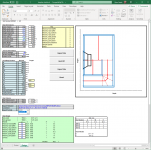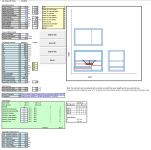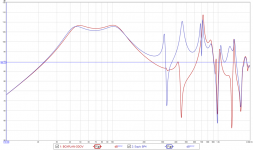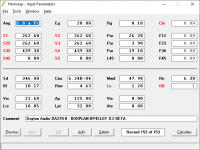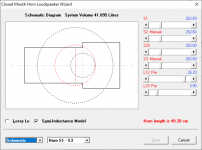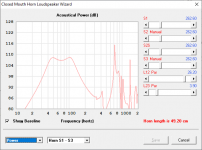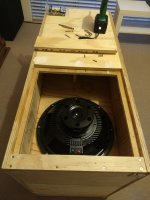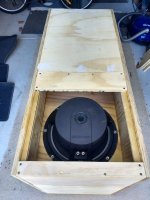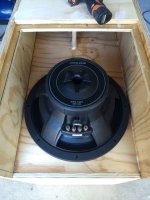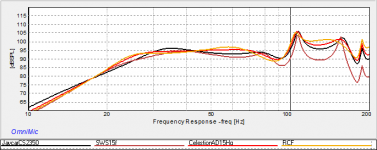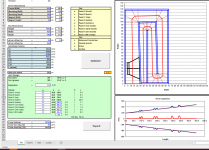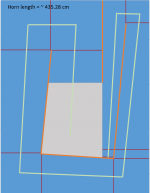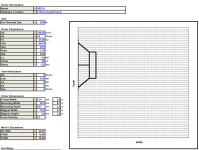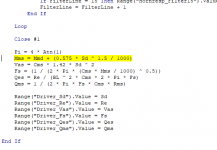I know it's a bit of an off topic, but i'm gonna ask hoping to get some advice.
I bought a driver relatively cheap - Hertz ES 300.5
Here are the specs:
Those specs suggest that particular driver isn't a good match for higher-order designs like tapped horns and the like. BL is too low (Qes is too high). Also Le is approaching Re, which suggests that, unless you measure this driver's impedance curve and use that to derive the semi-inductance parameters, Hornresp's predictions of its performance at upper bass frequencies in any alignment are likely to be off a bit.
There is a dent in response at about 60hz of an Othorn and from what i understand, the rest of the response should be EQed to that dent, crushing its sensitivity to about 91dB. Almost the same can be obtained from bass reflex. The Othorn enclosure provides 5-6Hz more but not much more sensitivty (due to a dent).
In the case of TH alignments, it's a balance between sensitivity and low frequency capability. A TH designed to have similar sensitivity to a BR with the same driver should have a lower Fb, as your models show. Resize it to have a similar Fb, and the overall sensitivity will increase.
An MLTL on the other hand is not going to provide much if any gain in sensitivity over a BR. However it usually has a larger vent which results in less power compression, and you can design for a wider usable bandwidth than you'd get from a typical big vent reflex design. It's my favourite type of alignment at the moment, though that might change, now that Hornresp can model offset driver / offset vent BR alignments
Attachments
Art,
Got it, thanks! This sub is going to support a pair synergy type speakers with Faital HF104 and 2 Beyma 8G40 per cabinet. The system won't be used at maximum volume (which is gonna be loud for this pair), so i just wanted to make a sub that is matched in terms of sensitivity. Since TH alignment doesn't buy me a lot of extra sensitivity i will just stick to a bass reflex.
For now, this system will be used for movies and background music for my old man when he is playing sax
Got it, thanks! This sub is going to support a pair synergy type speakers with Faital HF104 and 2 Beyma 8G40 per cabinet. The system won't be used at maximum volume (which is gonna be loud for this pair), so i just wanted to make a sub that is matched in terms of sensitivity. Since TH alignment doesn't buy me a lot of extra sensitivity i will just stick to a bass reflex.
For now, this system will be used for movies and background music for my old man when he is playing sax
Eg = input signal voltage. 2.83v into 8 ohms is the equivalent of 1W
Rg = The expected resistance of any elements (cables, etc.) that are going to be between the amplifier and the your speaker.
If you're getting a run-time file not found error, that means that the value that you have in the "Filename" cell is not pointing to a valid location on your PC.
Rg = The expected resistance of any elements (cables, etc.) that are going to be between the amplifier and the your speaker.
If you're getting a run-time file not found error, that means that the value that you have in the "Filename" cell is not pointing to a valid location on your PC.
Introducing BOXPLAN-BP4SLOT, a workbook that can be used to sim slot-loaded 4th order BP enclosures, using Hornresp's "offset-driver, offset-vent" model. This should produce a sim that's a bit more accurate than the BP4 model as the volume displaced by the vent and its location in the vented section of the box is taken into consideration.
Attachments
Probably depends on your objectives, I guess.
Some time back I went through all the box plan workbooks to see which path design yielded the greatest low end extension (path length) from the fixed floorspace I had in the corner of my lounge room to build a home theatre orientated sub for a 15" driver.
That turned out to be the Boxplan-MTH.
I was inspired by and aimed to create a passband similar to a well regarded tapped horn based on a 15" driver . These are more than $10k in Aus. I did this by estimating the path length and adjusting the height of my MTH till I had the passband I was aiming for.
This resulted in a box with a volume of 266 litres and a path length of about 450cm.
As an aside I tried 4 different drivers in my MTH:
All have very different specs, all worked (IMHO) really well, i.e. you can see the Hornresp modelled and ground plane measured differences, but in room, they all sound (to me) indistinguishable.
Perhaps the uber expensive RCF has the best "punch" - it is optimised for a horn application, but plays no louder than the Alpine that I picked up second hand for $90. That's the value of more Xmax, as I understand these things.
Tapped horn fun - which for me would not have been possible without Brian's fab Boxplot workbooks.

Some time back I went through all the box plan workbooks to see which path design yielded the greatest low end extension (path length) from the fixed floorspace I had in the corner of my lounge room to build a home theatre orientated sub for a 15" driver.
That turned out to be the Boxplan-MTH.
I was inspired by and aimed to create a passband similar to a well regarded tapped horn based on a 15" driver . These are more than $10k in Aus. I did this by estimating the path length and adjusting the height of my MTH till I had the passband I was aiming for.
This resulted in a box with a volume of 266 litres and a path length of about 450cm.
As an aside I tried 4 different drivers in my MTH:
- Alpine SWS15D2
- Celestion AD15H
- RCF LF15N451 and
- Jaycar Response Precision CS2350
All have very different specs, all worked (IMHO) really well, i.e. you can see the Hornresp modelled and ground plane measured differences, but in room, they all sound (to me) indistinguishable.
Perhaps the uber expensive RCF has the best "punch" - it is optimised for a horn application, but plays no louder than the Alpine that I picked up second hand for $90. That's the value of more Xmax, as I understand these things.
Tapped horn fun - which for me would not have been possible without Brian's fab Boxplot workbooks.

Attachments
Hey
I bought a SB23NRXS45-8 and I'm interested in building a TL sub out of it.
I have tried filling boxplan-mltl manually and from a hornresp driver but i get an error saying there is no mms and when i go to design tab and click "best fit" i get a runtime error.
Any ideas what am I doing wrong?
I bought a SB23NRXS45-8 and I'm interested in building a TL sub out of it.
I have tried filling boxplan-mltl manually and from a hornresp driver but i get an error saying there is no mms and when i go to design tab and click "best fit" i get a runtime error.
Any ideas what am I doing wrong?
Attachments
- Home
- Loudspeakers
- Subwoofers
- Spreadsheet for Folded Horn Layouts...
